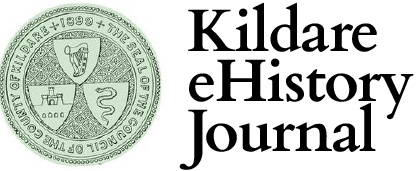The Allen Mass Rock

On the R415 Milltown to Allen road there is a spot where you can park your car, precariously, with a view to making your way to the top of the Hill of Allen. The ’round tower’ (Aylmer’s Folly) and views at the top are, understandably, what draws people back here time and again. Just as you approach the top, on the last leg of your gentle ascent, the views of the Bog of Allen open out to your right. As you cast your eye across the raised bog, you will spot turbines sprouting on the horizon.
But, long before you reach the top, there is another item of interest. A few hundred meters into the ascent, the path turns to the left. Just here, nestled into the foliage, is the Allen Mass rock. In days gone by, this was always a focal point of my family’s trips to the Hill, but not for the reasons you might imagine. This inconspicuous rock always drew my kids to it with an immutable power. No trip to the top was complete, or could be completed, without a pit stop here as the kids attempted to climb the rock’s craggy face. At that time, the stone was on the right hand side of the path. You will now find it on your left, after a recent relocation. This is nothing new, unfortunately. The story of this simple looking rock has long been one of displacement.
In his book Allen – A Memoir, Mıċeál Ó Dálaıġ recounts the struggle of the Catholic church for survival after the enactment of the Penal Laws. As he describes it: ‘In those perilous times, Allen was regarded as a place of refuge and retreat, and it can be forever proud of the welcome and protection it willingly gave the bishopric of Kildare and Leighlin’. He recounts the danger incurred in practicing the proscribed faith, and how services were held in isolated locations: ‘The Mass rock was a simple stone, often taken from the ruin of an old church. The priest arrived, disguised in plain clothes and placed the sacred vessels on the rock…Because the activity was illegal, the services were not scheduled and their occurrence was communicated verbally among the local community.’
As previously stated, the Mass stone has had a few different homes. Ó Dálaig explains that its current location on the path was not where it was originally to be found: ‘The original location of the Mass rock on the Hill is said to have been on the north-west face in Carrick. It was displaced from this position during the preparation of the hillside for plantation and it was later moved, to convenience quarrying operations, to its present location close to the Milltown Road.’
The Leinster Leader, January 22, 1955:
Despite the afforestation, the mining of the Hill, and the relocation of the stone, the Mass rock maintains a lingering resonance. You simply can’t pass by it, without being drawn to it. In his 1969 book Irish Priests In Penal Times, William P. Burke let it be known that: ‘Even far into the last century men who had remembered episodes in the penal times recounted them to Dr. Doyle the Bishop of Kildare.’ Burke was referring to memories that pertained in the nineteenth century.
More recently, however, there have been attempts to recognise and solemnify the sacrifices and courage of those who worshiped at this makeshift altar. The Leinster Leader, on 25 July 1987, reports of a Mass concelebrated by Bishop Laurence Ryan alongside the Allen Parish priest and others, in tribute to ‘…people of courage and strength, who assembled at this historic “Mass Corner”…’
Despite everything, the Hill is still a place of wonderment today. Whether you come for the tower at the top, the Mass rock on the way, or are hoping to catch a glimpse of our resurgent pine martens and red squirrels. An hour is never wasted on the great Hill of Allen.
Sources:
Allen – A Memoir, by Mıċeál Ó Dálaıġ
Irish Priests In Penal Times, by William P. Burke
The Leinster leader
By Kevin Dowling, Kildare County Archives and Local Studies.
